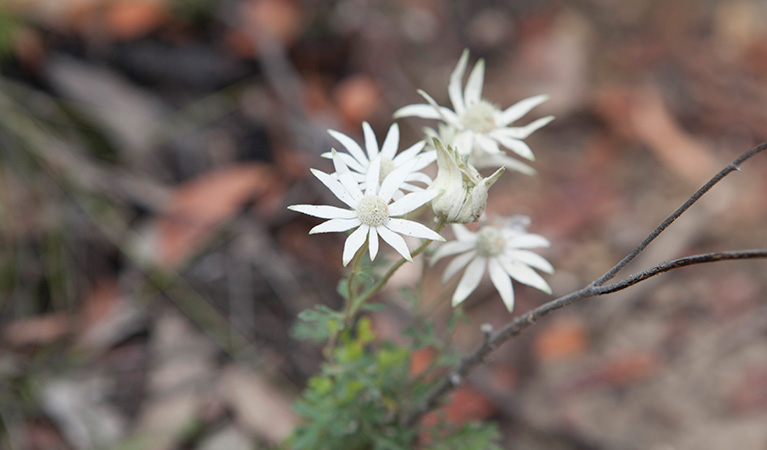Kurnell area
Kamay Botany Bay National Park
Learn more
Learn more about why this area is special
Kurnell area is in Kamay Botany Bay National Park. Here are just some of the reasons why this area is special:
Whale watching

June/July is the best time to see humpback whales in this area as they migrate to warmer waters, and Cape Solander is a terrific lookout to get a glimpse of these majestic ocean giants.
- Cape Solander Head to one of Sydney's best whale watching spots. Cape Solander, located in the Kurnell section of Kamay Botany Bay National Park is an unbeatable lookout during whale watching season.
- Kurnell Visitor Centre Kurnell Visitor Centre is closed while a new visitor centre is being built. You can still contact our staff for maps, history and advice by email or phone.
- Muru and Yena tracks Mura and Yena tracks form a short 2.5km loop walk and pass by Yena picnic area, in the Kurnell area. Enjoy coastal views, birds and wildflowers.
Aboriginal culture to discover

At the time of the first encounters with Europeans, Aboriginal people of 2 different nations – the Goorawal People and the Gweagal People – were living in the area which now includes Kamay Botany Bay National Park. Significant Aboriginal sites have been recorded in the park, including middens and engravings.
- Burrawang walk Take this short, wheelchair-accessible stroll along Burrawang walk in the Kurnell area and enjoy several historic sites. You can't miss the 3 bronze sculptures that mark the 250th anniversary of the e...
- Kamay Botany Bay Aboriginal cultural tours Join the Burraga Foundation on an Aboriginal cultural tour through the spectacular landscapes of Kurnell area in Kamay Botany Bay National Park. You’ll learn about the ancestral stories, practices and...
Historic heritage

Kurnell is Captain Cook's Landing Place and the point of first contact between Aboriginal people and the Endeavour crew. The Kurnell area of Kamay Botany Bay National Park is rich in both Aboriginal and European history and is certainly a cornerstone of the country's colonial history. One of Australia's earliest European explorers, James Cook, landed here in 1770. Cook's botanists, Joseph Banks and Daniel Solander, first explored Australia's natural world here. After the reports of Cook and Banks, Botany Bay was recommended as a suitable site for settlement but upon inspection by Captain Arthur Phillip it was found unsuitable as it had no secure fresh water or suitable anchorage – so Sydney Cove was set up as the penal colony instead
- Captain Cooks landing place Visit Kurnell to see Captain Cooks landing place and the place of encounter between Aboriginal Australians and the crew of the HMB Endeavour in 1770. This heritage-listed site is an important place in...
- Commemoration Flat picnic area Commemoration Flat picnic area is in the Kurnell area of Kamay Botany Bay National Park. This beautiful grassy spot is perfect for seaside family gatherings.
Sharing traditional knowledge

The Gamay Rangers have been appointed as ‘honorary rangers’ for Kamay Botany Bay National Park. Part of the Commonwealth Indigenous Ranger Program, which is designed to support Indigenous Australians to protect and conserve land and sea Country, the Gamay Rangers work alongside the NSW National Parks and Wildlife Service. The Gamay team share traditional knowledge and techniques, and are involved in the management of natural and cultural resources, protection of marine wildlife, and operation of the national parks on their cultural areas.
- Burrawang walk Take this short, wheelchair-accessible stroll along Burrawang walk in the Kurnell area and enjoy several historic sites. You can't miss the 3 bronze sculptures that mark the 250th anniversary of the e...
- Kamay Botany Bay Aboriginal cultural tours Join the Burraga Foundation on an Aboriginal cultural tour through the spectacular landscapes of Kurnell area in Kamay Botany Bay National Park. You’ll learn about the ancestral stories, practices and...
Plants and animals protected in this park
Animals
-

White-bellied sea eagle (Haliaeetus leucogaster)
White-bellied sea eagles can be easily identified by their white tail and dark grey wings. These raptors are often spotted cruising the coastal breezes throughout Australia, and make for some scenic bird watching. Powerful Australian birds of prey, they are known to mate for life, and return each year to the same nest to breed.
Plants
-

Blueberry ash (Elaeocarpus reticulatus)
The blueberry ash is a rainforest shrub which produces blue olive-shaped berries and spectacular bell-shaped flowers, which often appear on the plant together. It is a tall slender shrub or small tree found in rainforest, tall eucalypt forest and coastal bushland in eastern NSW, south-east Queensland and Victoria.
-

Flannel flower (Actinotus helianthi)
The delicate flannel flower is so named because of the soft woolly feel of the plant. Growing in the NSW south coast region, extending to Narrabri in the Central West and up to south-east Queensland, its white or pink flowers bloom all year long, with an extra burst of colour in the spring.
-

Old man banksia (Banksia serrata)
Hardy Australian native plants, old man banksias can be found along the coast, and in the dry sclerophyll forests and sandstone mountain ranges of NSW. With roughened bark and gnarled limbs, they produce a distinctive cylindrical yellow-green banksia flower which blossoms from summer to early autumn.
-

Smooth-barked apple (Angophora costata)
Smooth-barked apple gums, also known as Sydney red gum or rusty gum trees, are Australian native plants found along the NSW coast, and in the Sydney basin and parts of Queensland. Growing to heights of 15-30m, the russet-coloured angophoras shed their bark in spring to reveal spectacular new salmon-coloured bark.
Look out for...
Old man banksia
Banksia serrata

Hardy Australian native plants, old man banksias can be found along the coast, and in the dry sclerophyll forests and sandstone mountain ranges of NSW. With roughened bark and gnarled limbs, they produce a distinctive cylindrical yellow-green banksia flower which blossoms from summer to early autumn.
